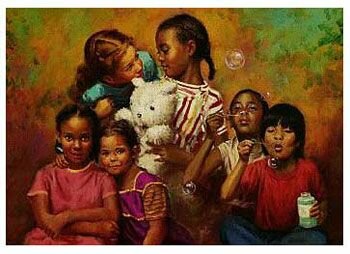2042, imagine
Visions 2042 — By Guest Author on May 24, 2010 at 05:57By Jamie Branam Kridler
The year 2042 certainly seems a Mecca for equality and justice compared to the days of slavery and even when compared to the eras of the civil rights movement. The courageous women and men of dangerous and critical times in the nation’s history are now actually the focus in history books studied by grade school and high school youth as well as college students.
The year 2042 may even seem like a utopia to the elders of the period as they recall the first days of integration and the challenges faced by individuals who were beginning to see equality as a worthwhile and ethical goal. Individuals who remember facing persecution for interracial romance and friendship also remember a society that did not share their desires for equality.
The turn of the 21st century brought positive change and hope for many disenfranchised people. The election of Barack Hussein Obama as President of the United States of America was met with great emotion on all sides. Fear and anger were driven by bigotry and ignorance for some, while joy and hope were experienced by others who saw a beautiful, talented, and intelligent family that looked like no previous occupants of the White House.
The image projected to the world a new and positive movement within the United States. Hope that the standard of “whiteness” as the symbol of power and privilege was changing. The bright new appearance of the United States as open to election of a man of color greatly improved global attitudes in a time when the nation’s commitment to equality and justice was under serious scrutiny. A black man full of dreams, hope, intelligence and vision gave most of the nation great insight into where the nation had been, where it was, and where it was going.
Toward the end of the 20th century another man was quietly making his presence known in Harlem. By the beginning of the 21st century the nation began to know more about Geoffrey Canada and his work with children and families in Harlem.
The model he created in Harlem has become a model for large cities throughout the nation and is credited for the major strides in education and resiliency factors in inner city youth. Inner city youth in 2042 excel in academics and return to their communities on a regular basis to work and live after graduating from college. Equal access to excellent education resulted in bright futures. Geoff Canada managed to create environments that encouraged successful youth to embrace their inner city heritage and communities and return to share their gifts with families and children in their old neighborhoods.
Mr. Canada’s notion of how to transform schools, neighborhoods and the family lives of poor children so they could compete successfully with middle income children was controversial at first. But when that practical approach produced positive results for youth and produced quantifiable research results it caught fire. His campaign to change Harlem became his campaign to change America. In 2042 a frail and elderly Geoff Canada can smile and reminisce as he looks back at the fruits of his labor. In his early work he felt his efforts and the nation’s to save a few chosen high-risk children was not enough and maybe even ethically questionable.
Society had to find a way to effect change for enough children and their families that the change in these individuals would actually begin to change the landscape of the neighborhoods and communities where they lived. His efforts eventually got the attention of policy makers and programs emerged in the private and public sector based on his concepts and resulted in elevating everyone in the community.
Conversations around race, ethnicity and heritage have greatly evolved by 2042. Race is rarely discussed since the youth prefer to speak of heritage and mixed heritage as opposed to race and ethnicity. The dialog generally centers on how earlier generations got it all wrong. The evidence and progress toward equality is impressive but bittersweet. Assimilation has occurred to a great degree but in the process a great deal of culture and heritage has been sacrificed.
The beauty and history of race and ethnicity has been sacrificed for acculturation. The positive outcomes include peace and increased understanding; however, the elders of the period are aware of the need to discuss race and the fact that race matters. Power and control has been the domain of the white, straight, male. Power and control was not given up by these men even as their status as the majority began to wane. Powerful positions in government and the private sector are still dominated by white males. People of color have made gains but fewer of those gains accrue to women and to gay and lesbian people.
People of color that are also women, gay and/or lesbian have fared the poorest. These groups continue to struggle for recognition and to be fully engaged in the political, economic, and the social process. A history of 266 years with more than 230 of those years dominated by white male rule takes many years to overcome. Evolution into an inclusive nation does not happen overnight.
The questions are different in 2042 than at other times in history. The people and the government have accepted the need and responsibility to provide every child and family with equal access to education and career opportunities as well as food, healthcare, and safe/healthy communities.
The move to provide equal access has resulted in decreased levels of poverty and fewer individuals serving time in prisons and jails. Addictions are treated as disease and healthcare is provided as opposed to prison sentences. The questions now center on newly marginalized populations and the sacrifice of lost, unique history and heritage as increased levels of assimilation continue to occur. It is trite but true to note that unexamined histories and lives tend to lead to repeated mistakes.
Native people of the Americas lost most of their heritage as a result of acculturation and assimilation. The questions of 2042 center around how to include newly marginalized populations and how to remember and honor all people’s race, ethnicity, and heritage. Celebrating differences can be as powerful as increasing our common ground. Martin Luther King, Jr. asked the question “do we tear down or do we build?” Maybe the answer is in finding the balance.
###
Artist: Clement Micarelli
Jamie Branam Kridler, PhD, Professor of Human Development/Women’s Studies, East Tennessee State University and co-founding “mother” Community House Cooperative, Inc., a social change organization working for peace and justice in East Tennessee.
Tags: Barack Obama, race, racial, Racial Equity, racism, Talking about RaceAuthor: Guest Author (94 Articles)



 Share This
Share This Tweet This
Tweet This Digg This
Digg This Save to delicious
Save to delicious Stumble it
Stumble it





 Resource Wars
Resource Wars 10 Reasons not to read this
10 Reasons not to read this







